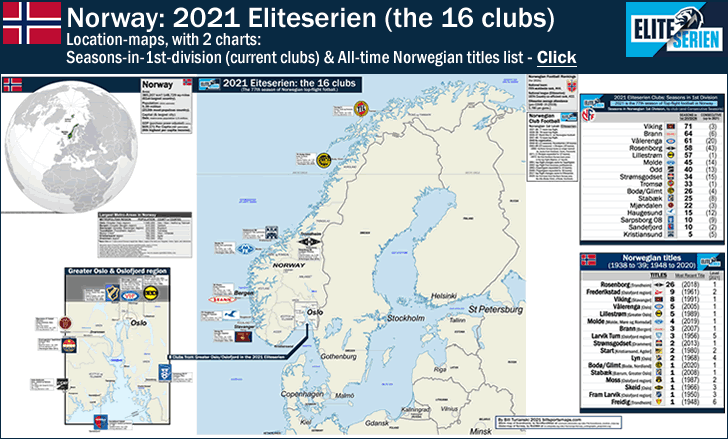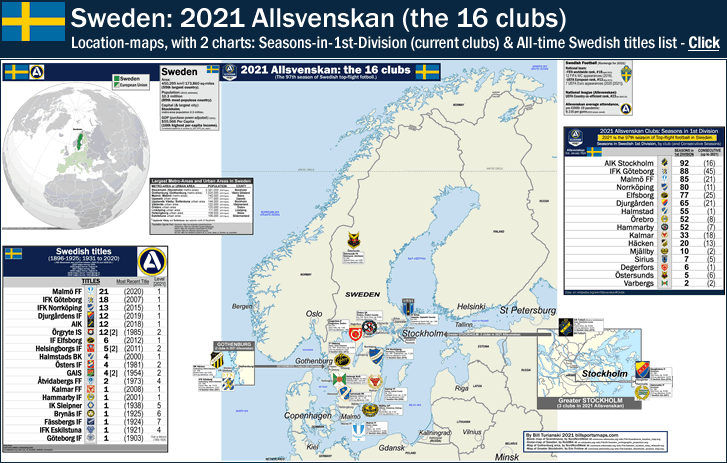
Norway: 2021 Eliteserien – Location-maps, with 2 charts: Seasons-in-1st-division (current clubs) & All-time Norwegian titles list
…
…
By Bill Turianski on the 16th of May 2021; twitter.com/billsportsmaps.
Links…
-Norway – Summary (table, fixtures, results, stats, etc) (soccerway.com).
-Eliteserien (en.wikipedia.org).
-Norwegian Eliteserien 2021 club-by-club preview, from reddit.com/soccer by ZxentixZ (from 9 May 2021, at us.reddit.com/r/soccer).
The map shows the 16 teams in the 2021 Eliteserien, the top-flight football league of Norway, which plays from May to November. On the map-page there is also an inset-map of the Greater Oslo/Oslofjord region, which shows the 8 Eliteserien teams from that area. There is also a bit of demographic info on Norway, found at the upper-left of the map page, and below that is a list showing all 7 metro-areas in Norway that have a population above 100,000.
On the map, for each the 16 Eliteserien clubs of 2021, there are shown the following:
Location, club crest, full club name and year of origin, stadium (and its capacity), 2019 average attendance [which was the most recent season before the COVID-19 pandemic affected attendance figures], and Norwegian titles.
At the upper-right of the map-page there is a brief history of Norwegian top-flight football [fotball].
And there are 2 charts. One chart shows Seasons-in-Top-flight for the current clubs (2021 is the 77th season of top-flight football in Norway). And another chart shows the All-time Norwegian titles list (1938-’39; 1947-2020).
A couple other notes…The inset-map of Greater Oslo/Oslofjord region shows the populated areas there in a pale-red colour. The main map shows all the cities in the Scandinavian and Baltic Sea regions which have metro-area populations above 400,000. Those 15 cities are…St Petersburg (Russia), Stockholm (Sweden), Copenhagen (Denmark), Minsk (Belarus), Oslo (Norway), Helsinki (Finland), Gothenburg (Sweden), Gdansk (Poland), Kiel (Germany), Riga (Latvia), Malmo (Sweden), Kaliningrad (Russia), Vilnius (Lithuania), Bergen (Norway), Tallinn (Estonia).
And the Arctic Circle is shown (see below for the reason for that).
Last season an unlikely champion was crowned in Norway: Bodø/Glimt
Bodø/Glimt are located just north of the Arctic Circle, in the small town of Bodø, Nordland, population, 52,000. (The town of Bodø is further north than Fairbanks, Alaska.) At the foot of this post, in the illustration for Bodø/Glimt, there is a synopsis of their history, which I will expand on a bit more below…
Before 1963, clubs from the north of Norway were not allowed to compete in the Norwegian Cup. That is, clubs from the two northern-most Norwegian counties of Nordland, and Troms og Finnmark, were barred by the Norwegian football authorities (the NFF, or Norges Fotballforbund. They also were barred from the Norwegian top flight.
It took until 1972 for the NFF to finally allow northern teams the right to compete for promotion to the top division. The first club from Northern Norway to gain promotion to the top flight was FK Mjølner, of Narvik, in 1972 (but they were relegated the following season). (I put Narvik on the map in case you were wondering where it is located.)
Why this long standing policy of exclusion? Well, by the 1970s, there were teams up north that were good enough – it was simply that the southern-biased NFF smugly felt otherwise. In 1975, Bodø/Glimt showed how good teams from the north were by becoming the first club from Northern Norway to win the Norwegian Football Cup.
But meanwhile, the NFF had stacked the deck against northern clubs trying to win promotion from the second tier. They did this right after the aforementioned FK Mjølner got promoted in 1972. So staring in 1973, the NFF put all the northern teams in a separate division – one of three divisions within the second tier – then made it much more difficult for the winner of that northern-subdivision. Because the other two subdivisions in the 2nd tier were comprised entirely of southern Norwegian teams, and the winners in both those subdivisions got instant promotion to the top flight. But the northern subdivision winner had to also win an extra playoff round (versus both the 2nd-place-finishers from the two southern subdivision) to gain promotion. This stilted system lasted until 1978.
This exclusionary state of affairs kept Bodø/Glimt out of the top flight for 3 years, until 1976, when they beat Odd BK 4-0 and drew 1-1 with FK Lyn. That made Bodø/Glimt the second club from Northern Norway to play in the top flight. (The only other club from Northern Norway to have gained promotion to the top flight is Tromsø IL.) In 1977, in Bodø/Glimt’s first season in the top tier, they finished in 2nd place, 8 points behind the champions, Lillestrøm.
…
Since then, Bodø/Glimt have won one more Norwegian Cup (in 1993), and have had a 13-year spell stuck back in the 2nd tier and 3rd tier (from 1980 to ’92), as well as a 13-year spell back in the top tier (from 1993 to 2005, including a 2nd-place-finish in 2003). Then, in the early 2000s they basically turned into a yo-yo club (3 relegations and 3 promotions since 2005). That all changed in 2019, when Bodø/Glimt turned into a competitor for the title once more, finishing in 2nd place. Then in 2020, Bodø/Glimt ran away with the title.
By winning the Eliteserien by 19-points last November, Bodø/Glimt became the northern-most team on the planet to have won a top-flight national football title. And so three years after their most recent promotion, Bodø/Glimt transformed themselves from a yo-yo club that inevitably sold off their best players in order to make ends meet, into the national champions.
In 2020, Bodø/Glimt scored an astounding 3.4 goals per game, and had a +71 goal difference. And Bodø/Glimt lost only twice all season – losing once to then-reigning champions Molde, and losing in the Europa League qualifiers to Italian giants AC Milan. Bodø/Glimt’s unusual title run has led many to call them the Leicester City of Scandinavia.
-Norway Has a Must-See Team. Barely Anyone Can Watch It. Bodo/Glimt is on the cusp of its first championship, a soccer success story built on style and innovation… (by Rory Smith on 8 Nov 2020 at nytimes.com/sport).
-Bodo/Glimt make history with Norwegian Eliteserien title win (from 22 Nov 2020, at bbc.com/football).
Bodø/Glimt – 2020 Norwegian champions

Photo and Image credits above – Aspmyra Stadion, by Stig-André Lippert at twitter.com/[@paabortebane]. Aerial shot of Bodø harbor and airstrip, photo from nordlandssykehuset.no. Aerial shot of Bodø, by Getty Images via forbes.com. Bodø air station with fighter plane aloft, photo from wikimapia.org/[Bodø airbase]. Bjørn Mannsverk beside fighter plane, photo by an.no via origo.hu/futball. Bodø/Glimt mental coach Bjørn Mannsverk, in a session with team-coach Håvard Sakariassen and captain Ulrik Saltnes, photo by Markus André Jensen via bodonu.no. Kjetil Knutsen, photo by Marius Simensen/Bildbyrån Norway via . Kjetil Knutsen with Bodø players, photo from time24.news. Kasper Junker, screenshot from video uploaded by Furkan Buğra Yolcu at youtube.com. Phillip Zinckernagel, screenshot from video uploaded by CSN Football Videos at youtube.com. Jens Peter Hauge, photo by @imagoimages via rossoneriblog.com. Ulrik Saltnes, photo by Mats Torbergsen (NTB scanpix) via nettavisen.no/sport. Bodø players celebrate after a goal, photo from glimt.no/om-klubben.
…
…
___
Thanks to all at the following links…
-Blank map of Scandinavia, by NordNordWest at File:Scandinavia location map.svg (commons.wikimedia.org).
-Globe-map of Norway, by Rob984 at File:Europe-Norway (orthographic projection).svg (en.wikipedia.org).
-Inset map of Oslofjord region – which I drew, tracing the following maps…blank map of Oslofjord region, by Demis.nl via File:La2-demis-oslofjorden.png (commons.wikimedia.org); Demis Map Server; Map of Oslofjord, by Finnrind at File:Oslofjord.svg; + Open Street Map [Oslofjord].
-Counties map of Norway, by Furfur at File:Nye fylker – regjeringen.no.svg (commons.wikimedia.org).
-Rankings: Norway club co-efficient: kassiesa.net; Norway national team: fifa.com/fifa-world-ranking.
-Norwegian football history: Det norske seriesystemet i fotball for menn (no.wikipedia.org).




